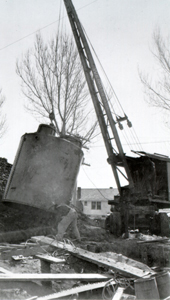from an interview with Ed Hilgenberg, who served Fort Collins for nearly thirty years as Water and Sewer Superintendent.
Interviewer: Erin Christensen

Sometime in the 1930s the State Health Department began putting pressure on the city of Fort Collins to build a sewage plant. Before this time, as in many communities, there was little consideration of the environmental effect of putting raw sewage into the rivers. "It got to the point where the contamination got so great that the fish and wildlife and aquatic life in the river was destroyed and the odors were terrible."
In the '30s and 40s sewer lines were made of vitrified clay tile with manholes made of brick and concrete. Vitrified clay is an inert matter and doesn't break down as does concrete. Lift stations had been built to lift the sewage from low-lying areas uphill until it could flow by gravity into the sewer systems.
The first lift station to be built, according to Hilgenberg's memory, was on Prospect Street just east of College Avenue; others followed at Maple and Howes and Fishback and Maple. About nine were built in the late 1920s or early 1930s and the last ones were not abandoned until 1965 when new trunk lines were built. There was no program of flushing out lines or regular maintenance at this time. Fort Collins was a small city, not experiencing much growth.
As the Prospect lift station was the first to be built, it was also the first to be replaced by a by-pass that flowed from the low lying Prospect street through the hill to Whedbee and then turned north. It was, and still is, according to Hilgenberg, twenty-five feet deep. This major project was the cooperative effort of the City and the Works Progress Administration of the Federal Government (WPA) to create jobs for the unemployed.
It was a provision of the WPA, that machinery couldn't be used when manpower would suffice, so the new line was built with all hand labor except at the very deepest part. There were several other WPA projects in town, such as the covering of the "Town Ditch," now called the "Arthur Ditch," the Golf Course, City Park Nine and many curb and gutter projects.
The Colorado Health Department finally gave the City an ultimatum about building a sewage treatment plant, but the public was not entirely in favor of the project. The City Manager thought it would freeze up in the winter, but this never happened. The plant was built using local builders and contractors and again, a lot of manual labor.
When the plant was built the public thought it was a good idea, except they realized they were then going to have to pay a sewage fee, which at the beginning was fifty cents a month.
By the time the waste water treatment system needed to be expanded, there was no longer any opposition. The state required the project, which was financed by a bond issue with some funds from the Federal Government.
A description of how the first sewage plant operated and the use of the "sludge" as fertilizer for nearby farms is included in Hilgenberg's "History of Fort Collins Waste Water District, 1930s-1982". Find the complete interview in the Archive's oral history collection. Hilgenberg worked for the City from the late thirties until he retired in 1981, after forty years of service.


Preserving the history of Fort Collins, Colorado & the Cache la Poudre region